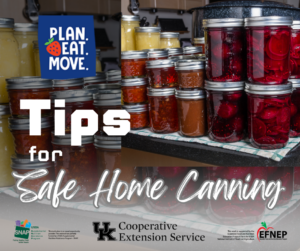Now is a great time to start canning. You can preserve some of your own fruits and vegetables or take advantage of the bounty of locally grown fruits and vegetables at your county’s farmers market. Home canning can save money, provide gifts for family and friends and leave you with feelings of great accomplishment. For the best canned products be sure to follow USDA recommendations.

- Start with fresh fruits and vegetables. Spoilage and loss of vitamins and nutrients begins right after harvest so you want to can fruits and vegetables at their peak.
- Wash all produce. Rinse under running water to dislodge any dirt, leaves, or stems. Trim and cut according to the recipe.
- Use only research-based recipes. The Ball Blue Book Guide to Preserving is full of great tested and USDA-approved recipes for both water baths and pressure canning. Follow the recipe exactly. Do not add more or less of any ingredient and do not add your own ingredients to the recipe.
- High-acid foods like fruits, tomatoes with lemon juice added or pickles can be safely canned in a boiling water bath canner. Remember to follow USDA-approved recipes.
- Low acid foods like green beans, corn and all other vegetables, as well as meat and poultry, must be canned in a pressure canner. Low acid foods must be processed at 240 degrees F in order to destroy heat resistant bacteria, spores and the toxins they produce. Again, it is important to follow a USDA approved recipe.
- When using a pressure canner, follow the manufacturer’s instructions. Dial gauge pressure canners should be tested each year for accuracy. Your local Extension Office should be able to do this for you.
- Use only Mason-type jars designed for home canning with self-sealing lids. Old mayonnaise and other commercial glass food jars are not as thick as the Mason canning jars and are more likely to break in the canner. Jars and rings may be reused if in good condition. Self-sealing lids should only be used once.
- Process jars for the full time specified in the recipe. Start timing the water bath canner once the water has reached a full boil. Start timing the pressure canner once the canner has vented for 10 minutes and reaches the correct pressure.
- After processing, cool jars slowly and test seals after at least 12 hours. Unsealed jars may be reprocessed within 24 hours for the full processing time or refrigerated and used within several days.
- Store sealed jars in a cool, dry, dark place. Remember to date them. When properly stored, home canned foods may be kept for two years.